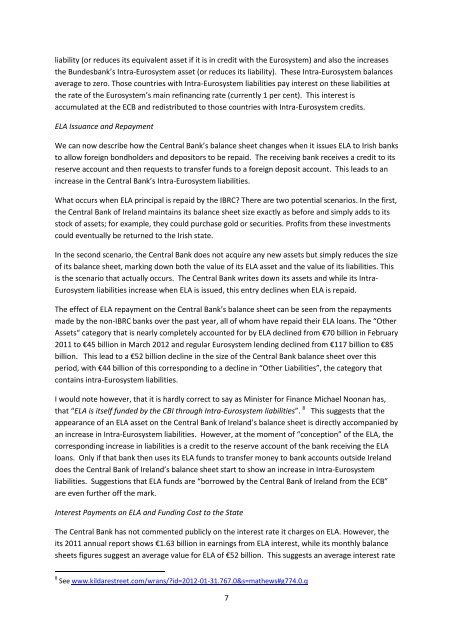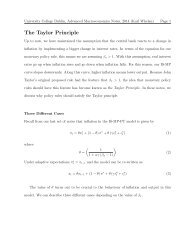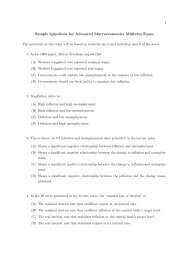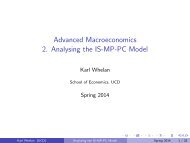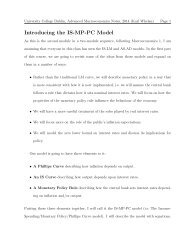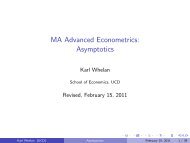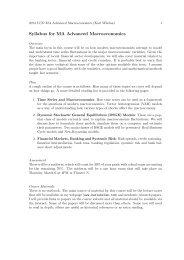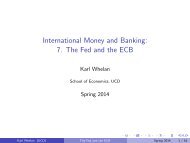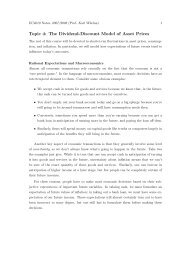ELA, Promissory Notes and All That: The Fiscal Costs ... - Karl Whelan
ELA, Promissory Notes and All That: The Fiscal Costs ... - Karl Whelan
ELA, Promissory Notes and All That: The Fiscal Costs ... - Karl Whelan
Create successful ePaper yourself
Turn your PDF publications into a flip-book with our unique Google optimized e-Paper software.
liability (or reduces its equivalent asset if it is in credit with the Eurosystem) <strong>and</strong> also the increases<br />
the Bundesbank’s Intra-Eurosystem asset (or reduces its liability). <strong>The</strong>se Intra-Eurosystem balances<br />
average to zero. Those countries with Intra-Eurosystem liabilities pay interest on these liabilities at<br />
the rate of the Eurosystem’s main refinancing rate (currently 1 per cent). This interest is<br />
accumulated at the ECB <strong>and</strong> redistributed to those countries with Intra-Eurosystem credits.<br />
<strong>ELA</strong> Issuance <strong>and</strong> Repayment<br />
We can now describe how the Central Bank’s balance sheet changes when it issues <strong>ELA</strong> to Irish banks<br />
to allow foreign bondholders <strong>and</strong> depositors to be repaid. <strong>The</strong> receiving bank receives a credit to its<br />
reserve account <strong>and</strong> then requests to transfer funds to a foreign deposit account. This leads to an<br />
increase in the Central Bank’s Intra-Eurosystem liabilities.<br />
What occurs when <strong>ELA</strong> principal is repaid by the IBRC? <strong>The</strong>re are two potential scenarios. In the first,<br />
the Central Bank of Irel<strong>and</strong> maintains its balance sheet size exactly as before <strong>and</strong> simply adds to its<br />
stock of assets; for example, they could purchase gold or securities. Profits from these investments<br />
could eventually be returned to the Irish state.<br />
In the second scenario, the Central Bank does not acquire any new assets but simply reduces the size<br />
of its balance sheet, marking down both the value of its <strong>ELA</strong> asset <strong>and</strong> the value of its liabilities. This<br />
is the scenario that actually occurs. <strong>The</strong> Central Bank writes down its assets <strong>and</strong> while its Intra-<br />
Eurosystem liabilities increase when <strong>ELA</strong> is issued, this entry declines when <strong>ELA</strong> is repaid.<br />
<strong>The</strong> effect of <strong>ELA</strong> repayment on the Central Bank’s balance sheet can be seen from the repayments<br />
made by the non-IBRC banks over the past year, all of whom have repaid their <strong>ELA</strong> loans. <strong>The</strong> “Other<br />
Assets“ category that is nearly completely accounted for by <strong>ELA</strong> declined from €70 billion in February<br />
2011 to €45 billion in March 2012 <strong>and</strong> regular Eurosystem lending declined from €117 billion to €85<br />
billion. This lead to a €52 billion decline in the size of the Central Bank balance sheet over this<br />
period, with €44 billion of this corresponding to a decline in “Other Liabilities”, the category that<br />
contains intra-Eurosystem liabilities.<br />
I would note however, that it is hardly correct to say as Minister for Finance Michael Noonan has,<br />
that “<strong>ELA</strong> is itself funded by the CBI through Intra-Eurosystem liabilities”. 8 This suggests that the<br />
appearance of an <strong>ELA</strong> asset on the Central Bank of Irel<strong>and</strong>’s balance sheet is directly accompanied by<br />
an increase in Intra-Eurosystem liabilities. However, at the moment of “conception” of the <strong>ELA</strong>, the<br />
corresponding increase in liabilities is a credit to the reserve account of the bank receiving the <strong>ELA</strong><br />
loans. Only if that bank then uses its <strong>ELA</strong> funds to transfer money to bank accounts outside Irel<strong>and</strong><br />
does the Central Bank of Irel<strong>and</strong>’s balance sheet start to show an increase in Intra-Eurosystem<br />
liabilities. Suggestions that <strong>ELA</strong> funds are “borrowed by the Central Bank of Irel<strong>and</strong> from the ECB”<br />
are even further off the mark.<br />
Interest Payments on <strong>ELA</strong> <strong>and</strong> Funding Cost to the State<br />
<strong>The</strong> Central Bank has not commented publicly on the interest rate it charges on <strong>ELA</strong>. However, the<br />
its 2011 annual report shows €1.63 billion in earnings from <strong>ELA</strong> interest, while its monthly balance<br />
sheets figures suggest an average value for <strong>ELA</strong> of €52 billion. This suggests an average interest rate<br />
8 See www.kildarestreet.com/wrans/?id=2012-01-31.767.0&s=mathews#g774.0.q<br />
7


